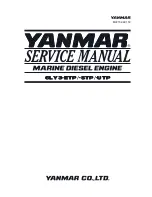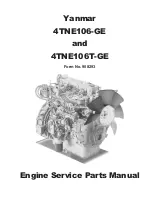
The silencer is mounted to the
engine using the two steel socket-
cap screws, two spring washers,
two square retaining nuts and
the gasket provided. Also make
sure to tighten the screws firmly.
Notice that the nuts slide behind
the muffler mounting flange on the
engine.
IMPORTANT
The standard silencer can be mounted only in the direction
shown. Optional replacement silencers are available.
3
STARTING PROCEDURE
Propeller Installation
WARNING
Before installing the propeller it must be properly balanced.
Balance the propeller AFTER drilling both the centre hole and the four radial
holes. Running your engine using an out-of-balance propeller can lead
to excessive vibration, which will result in excessive stress and wear on
both the engine and the airframe. Balance the propeller using the method
recommended by the propeller manufacturer. Several products are
available to properly balance propellers. Ask your local retailer for more
information about these items.
The diameter of the propeller
retaining bolt is 8mm (0.315").
Using a drill bit or a propeller
reamer, enlarge the hole in the
propeller hub to fit the retaining
bolt. Slide the propeller retaining
bolt and the propeller washer onto
the propeller, then use the holes in
the propeller washer to mark the
locations of the four radial retain-
ing bolts onto the propeller.
Remove the retaining nut and pro-
peller washer, then drill four 4mm
(5/32") diameter holes through the
propeller. If you have one, we
suggest using a drill press to drill
these holes.
Install your propeller loose to make
it easy to line up and thread the four radial retaining bolts into place. Finally,
tighten the centre bolt, then tighten the four radial bolts in a criss-cross
pattern.
WARNING
If you are installing a spinner onto your engine, the cone of
the spinner must not rub against the propeller. Allowing the spinner cone
to rub against the propeller could lead to propeller damage and eventual
propeller failure. We also strongly suggest balancing your spinner before
installing it.
We suggest using only high-quality propellers made from wood, carbon-fibre
or glass-reinforced nylon. Don't forget to balance the propeller as described
in the previous section.
PROPELLER SIzE RECOMMENDATIONS FOR THOR 45 CDI ENGINE
Propeller Recommendation
PROPELLER, FUEL AND SPARK PLUG
Use for
Running-In
20 x 8
22 x 8
20 x 10
Spark Plug Recommendation
The spark plug included with your engine is designed specifically for your
engine. Factory replacements are available and can be purchased directly
from your THOR engine dealer. When purchasing a new spark plug we
suggest double-checking the gap using a gap gauge tool found at auto-parts
shops. The spark plug gap should be set to a gap of 0.7mm (.028") with
the spark plug cold. The spark plug should be replaced when signs of
electrode wear are present.
Fuel Recommendation
The fuel you use should be high-octane (89 or 91) premium unleaded
petrol mixed with a high-quality synthetic two-stroke engine oil (Castrol TTS
recommended) at a ratio of 25:1 for the first 2-3 hours of run-time and a
ratio of 40:1 thereafter. We don't suggest using more oil than recommended
since damage to the piston rings and piston could result. We also don't
suggest adding performance-boosting additives to your fuel. Doing so
will void your engine's warranty.
IMPORTANT
Always mix your fuel in a clean container and filter it before
filling your fuel tank. We also strongly recommend using an in-line fuel filter
between your fuel tank and the carburettor. 'Felt' type fuel tank clunks are
also recommended.
High and Low Speed Mixture Screws
The high speed mixture screw is used to meter the air/fuel mixture at full
throttle. The low speed mixture screw regulates the air/fuel mixture at idle
and during transition from idle to full throttle. Both mixture screws operate
the same. Turn the mixture screw(s) clockwise to lean the mixture or turn the
mixture screw(s) counterclockwise to richen the mixture. Both mixture screws
are preset from the factory for initial starting. They will need final adjusting to
suit your atmospheric conditions, fuel, temperature, altitude, etc.
If your high and low speed mixture screws get too far out of adjustment,
reset them to the factory settings:
High Speed Mixture Screw:
1.5 turns out from fully closed.
Low Speed Mixture Screw:
1.5 turns out from fully closed.
CARBURETTOR ADJUSTMENT SCREWS
Idle Stop Screw
Although we suggest using your transmitter's idle trim lever to set the
idle speed of the engine, you can also set the idle speed of the engine
using the idle adjustment screw on the carburettor. Turning the screw
clockwise will increase the idle speed and turning the screw counterclockwise
will decrease the idle speed. The screw is set at the factory and should not
require adjustment.
The starting procedure for the THOR 45 CDI engine is actually quite simple.
For ease of starting we recommend using a high-torque electric starter with a
good quality 12V car battery. The engine can be started by hand, but only using
a chicken stick. We strongly discourage it, but if you must use your hand to start
the engine, you
MUST
wear a heavy-duty leather glove.
Verify that the ignition kill switch is in the "off" position and fill the fuel tank
with fresh, filtered fuel.
Before filling the fuel tank, gently shake your fuel
container to remix the oil and petrol mixture.
Open the throttle completely, close the choke and rotate the propeller
by hand counterclockwise through the compression stroke 4-6 times to prime the
engine. Open the choke. The first start may require a lot more rotations to prime
the carburettor for the first time.
Set the throttle to idle, then pull the propeller slowly through the compression
stroke once, leaving the propeller just below the top of the next compression
stroke.
Turn on the kill switch and start the engine using an electric starter or by
hand. If starting by hand, the engine should start within about 5 or 6 flips.
Once the engine starts, maintain a fast idle for no less than 1 minute to allow
the engine to warm up.
IMPORTANT
Make sure you never start the engine with the carburettor
set any higher than the idle setting. Trying to start the engine at a higher
throttle setting can result in the engine backfiring or lurching forward. This
can quickly lead to damage to the engine and/or personal injury.
2
The THOR 45 CDI engine features direct-to-firewall mounting. The firewall in
your model should be aircraft grade 5-ply plywood no less than 9.5mm (3/8")
thick and the firewall should be reinforced to meet the torque and weight of
the engine. Use only high-quality 5mm
steel cap screws and related hardware
to mount the engine.
Should you decide to mount the engine
using rubber shock mounts, we strongly
suggest using high-quality mounts
designed specifically for single cylinder
petrol engines. Using the wrong type of rubber shock mounts can lead to an
erratic running engine and possible engine damage.
ENGINE INSTALLATION
Engine Orientation
The THOR 45 CDI engine features a high-quality Walbro carburettor with
an integrated fuel pump, so the engine can be orientated in any position
on the firewall without the fuel-draw problems associated with non-pumped
engines.
Engine Bolts & Firewall Requirements
The ignition module should be mounted near the engine, as far away
from your airborne radio equipment as possible. It should be protected
from excessive heat, vibration and fuel oil. We recommend wrapping it in
foam rubber (like used for your receiver), then securing it into place using
double-sided tape or silicone glue.
You will need to install a kill switch (sold separately) between the ignition module
and your ignition battery. The kill switch should be mounted in a convenient
location on the outside of the model far enough away from the engine so as not
to pose a risk when using the switch.
For models over 7kg in the U.K. this
switch should be operated by the radio
so that the engine can be switched off
by the ‘failsafe’ system.
To power the ignition system you will
need to use a separate battery pack
that is 6.0V (5 cells) and a capacity of
1100mAH to 3000mAH. NiCd or NiMH
cells can be used. The battery should be wired to the kill switch (making sure
that the polarity is correct) and mounted inside your model, at least 300mm
(12") away from the ignition module. For convenience, a charge jack can be
wired along with the kill switch so that you can charge the battery without
having to remove it from the model. A standard on/off switch (or connectors)
with a charge jack works well.
To ground the ignition system, slide the ‘ground’ cable harness over the
threaded end of the spark plug, then install the spark plug into the engine
(make sure that it's tightened securely). Push the rubber cap over the end of
the spark plug until it snaps firmly down
into place.
Next, plug the ignition wire from the
engine into the matching ignition wire
from the ignition module.
IMPORTANT
The ignition sensor is pre-installed at the factory in the
correct position. Do not attempt to adjust the sensor mount.
Ignition System Installation
Throttle Pushrod Installation
To reduce the chance of radio "noise", we don't recommend using a metal
pushrod wire. We suggest using a nylon tube-in-sleeve style pushrod. Make
sure to attach the pushrod to the throttle lever using a heavy-duty nylon
clevis. You want to avoid any metal-to-metal contact.
IMPORTANT
Do not remove the throttle lever spring. This spring helps
keep the carburetor butterfly aligned properly. Merely release the ends of
the spring so that it no longer holds the butterfly closed. This will ease the
strain on your throttle servo.
Choke Rod Installation
If the carburettor is accessible, we suggest leaving the choke open, and using
your finger to cover the carburettor opening to choke the engine. If this is not
possible, you can attach a choke rod to the choke lever. As with the throttle
pushrod, make sure to use a heavy-duty nylon clevis to secure the choke rod
to the choke lever.
IMPORTANT
If the choke rod is more than 75mm (3") long, we sug-
gest supporting the outer end of the choke rod to prevent vibration from
damaging the choke mechanism.
Silencer Installation
IMPORTANT
Because this is a petrol engine, your fuel system (fuel tank
and stopper assembly, fuel lines, filters, fuel valves, etc) must be designed
for use with petrol. Do not use accessories designed for use with glow fuel.
Do not use silicone-based materials.
The THOR 45 CDI engine uses a Walbro carburettor with an integrated
fuel pump. For this reason, the location of the fuel tank is not critical. The
pump will draw fuel into the carburettor regardless of the location of the
fuel tank. For best aircraft performance we suggest installing the fuel tank
over the models C/G so that no trim changes will be necessary as the fuel
quantity lowers in the tank.
We recommend using a fuel tank no smaller than 570ml (20 oz). Make
sure that the fuel tank is vented outside of the model during use. Exhaust
pressurisation is not required and would actually be detrimental to the
running.
Fuel System
Proper cooling is vital to ensure proper running and longevity from your
engine. It is imperative that your model be constructed to provide adequate
airflow over the engine and muffler. This means having appropriately sized
air-intake and air-exit areas. For proper cooling the air-exit area should be 4
times the size of the air-intake area. For example, 65cm
2
(10 in
2
) of air-
intake area will require 650cm
2
(40 in
2
) of air-exit area. This formula ensures
that your engine will not overheat due to inadequate air flow.
Engine Cooling






















